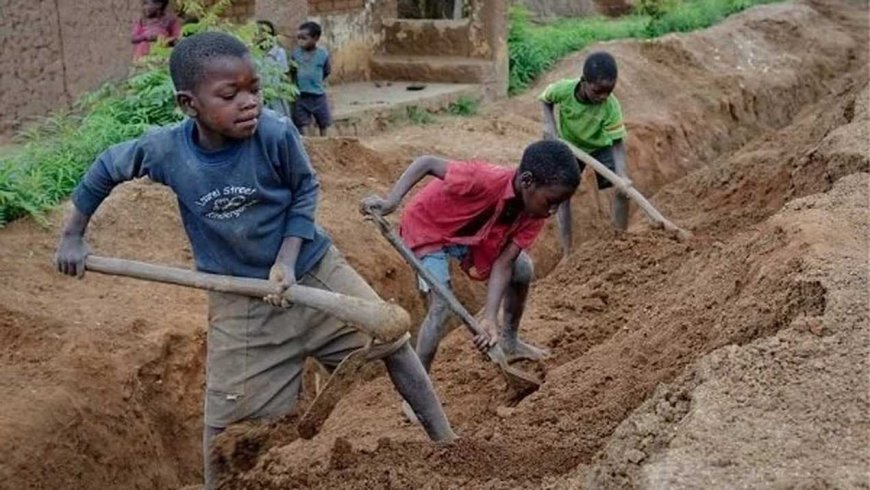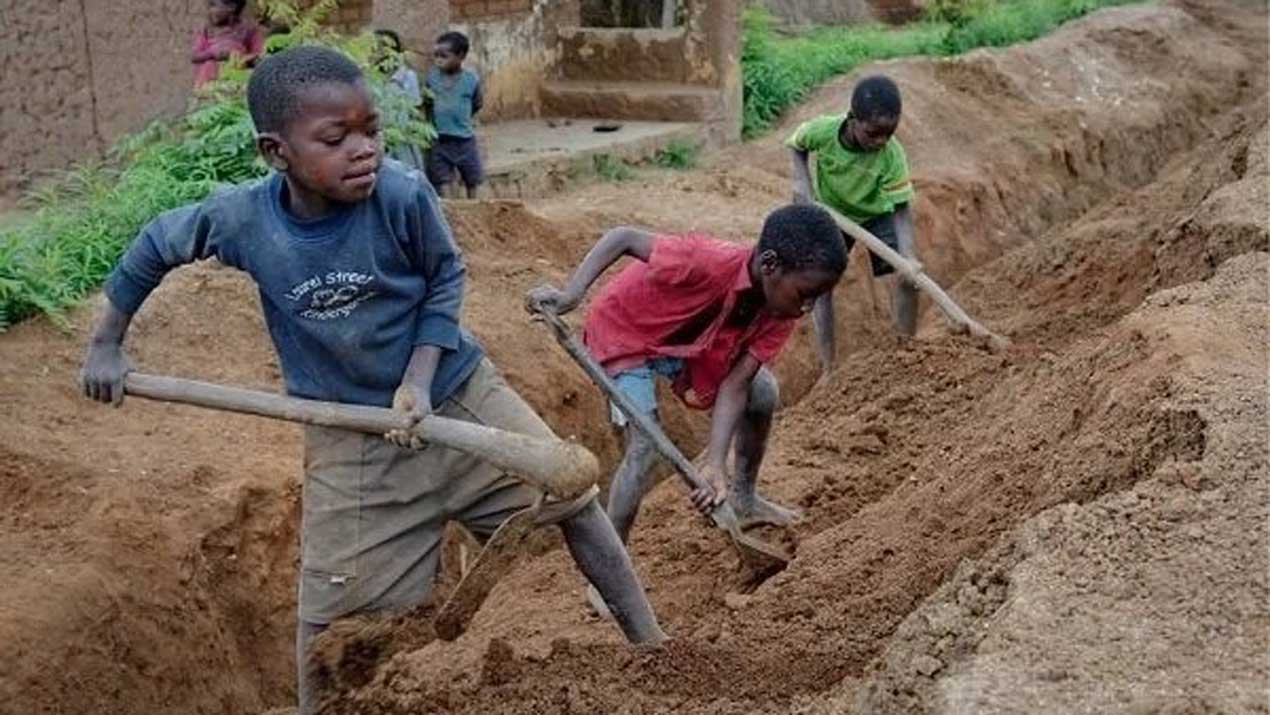Protect the future, eliminate child labour
Protect the future, eliminate child labour Guardian Nigeria


The Challenge of Child Labour in Nigeria
The alarm raised by Public policy think tank group Nextier and the country director of the International Labour Organization (ILO) that no fewer than 15 million Nigerian children are engaged in child labour in Nigeria is quite frightening. It is yet another manifestation of poverty that is deep in the land, and needs to be addressed frontally in the interest of the country’s future. Child labour in Nigeria takes various forms and occurs in different sectors, including agriculture, domestic work, street vending, and informal industries.
The Impact on Nigerian Children
Millions of Nigerian children, who are deprived of their childhood and human dignity are engaged in work that is mentally, physically, socially, or morally harmful to them and even compromises their schooling.
Causes and Forms of Child Labour
Widespread use and exploitation of child labour in Nigeria, according to most accounts, is on the rise due to persistent poverty in the country. Nigerian children are subjected to commercial sexual exploitation, child trading, child hawking, and other hazardous activities such as making children trek far and wide to fetch water and firewood.
- Children aged between five and 14 years, without basic education, roam the streets in search of survival.
- Poor Nigerian parents are deceived into believing that their children will be well looked after and given decent legal employment, only for the children to be initiated into atrocious child labour and exploited through hours of low-paying jobs and exposure to hazardous environments.
- Children are also enlisted to do heavy work on farmlands and in factories.
The Issue of Sexual Exploitation
One of the most disturbing aspects of child labor is the growing demand for children for sexual purposes. According to the United States Bureau of International Labor Affairs, Nigeria continues to be a source, transit, and destination country for sex trafficking of children. Apart from Italy, Nigerian young prostitutes have invaded Spain, Germany, Belgium, Austria, the United Kingdom, and other countries. They constitute the largest group of prostitutes in Norway, with over 500 underage Nigerian prostitutes working in the Netherlands. Most of these prostitutes are recruited through the human trafficking industry. The majority of the young victims of this trafficking are unsuspecting young girls who are enticed with promises of good jobs abroad, only to be coerced into prostitution overseas.
Factors Contributing to Child Labour
Apart from poverty, other causative factors of child labour in Nigeria include poverty, lack of access to quality education, cultural practices, and a lack of enforcement of child labour laws. Families facing economic hardship often rely on child labor as a means of survival. Urban poverty and deprivation have forced millions of Nigerian children onto the streets. Often, these young children are seen hawking their wares in the streets of Nigeria, and in the process, some are sexually abused, while others are exposed to the most hazardous and unfriendly environments. The tragedy of child labor in Nigeria is that a large proportion of Nigerian children who are denied basic education are forced into premature adulthood by being made to perform work meant for adults. Too many Nigerian families depend on the income, however small, brought in by their children.
Policy Interventions and Solutions
Government at all levels can pursue effective policies to combat this vice, partly by partnering with relevant NGOs, private agencies, voluntary organizations, civil society organizations, Churches, Mosques, and neighborhood organizations. These efforts should include:
- Awareness campaigns
- Provision of educational and vocational training opportunities
- Advocacy for stricter enforcement of child labour laws
Child workers should be encouraged to attend school and learn new skills, and above all, not give up hope for a better future. Given the strong cultural belief that children should be seen and not heard, parents should be enlightened about child labour and children’s legal rights.
The Need for Strengthened Laws and Regulations
Nigeria has various laws and regulations protecting Nigerian children from child labour. However, these laws and regulations are hardly adhered to or enforced. The Nigerian Labour Act, the Child Rights Act, and the National Policy on Child Labour are among the legal instruments aimed at addressing the vexed issue. However, the enforcement and implementation of these laws remain significant challenges. For instance, the Child’s Right Act has outlawed child labour, but many states of the federation are yet to embrace or domesticate the Act, often on cultural and religious grounds. The central government should reach a consensus with the objecting states on the legal framework that will protect children from child labour. Government should ensure that labour inspectors receive sufficient financial, technical, and human resources to enforce child labour laws.
Protecting Children’s Rights
There is need also for mass enlightenment to make adults understand that children have rights that should be protected. The Convention on the Rights of the Child (CRC) in 1989, signed and ratified by Nigeria, remains the benchmark for assessing the rights of our children. The CRC states that every child, before and after birth, should have the right to life, the right to basic education, the right not to be coerced into engaging in any unlawful sexual activity, the right not to be abducted and sold into slavery, freedom of expression, the right not to be used for forced labor, child trade, child trafficking, and so forth. Therefore, the various child protection mechanisms should be strengthened, including child protection services such as hotlines and counseling services for children in need.
Collaboration and Support
The government should create efficient mechanisms for reporting and investigating child labour cases. Government, civil society organizations, NGOs, and voluntary organizations should provide financial incentives and scholarships to encourage child enrollment and attendance in schools. The government should initiate community programs in efforts to combat child labour and to emphasize the importance of protecting children’s rights. The authorities should encourage businesses to adopt and enforce ethical labor practices, including supply chain monitoring. The government should seek the collaboration of corporate bodies and international organizations, such as the ILO and UNICEF, for technical assistance and resources.
A Brighter Future for Nigerian Children
Rather than subject children to all manner of child labour, they should be provided with the opportunity to develop physically, mentally, morally, spiritually, and socially in a healthy environment, while enjoying conditions of freedom and dignity. This is the only way the country can hope to nurture the future leaders of tomorrow.
SDGs, Targets, and Indicators
-
SDG 1: No Poverty
- Target 1.2: By 2030, reduce at least by half the proportion of men, women, and children of all ages living in poverty in all its dimensions according to national definitions.
- Indicator 1.2.1: Proportion of population living below the national poverty line, by sex and age group.
-
SDG 4: Quality Education
- Target 4.1: By 2030, ensure that all girls and boys complete free, equitable and quality primary and secondary education leading to relevant and effective learning outcomes.
- Indicator 4.1.1: Proportion of children and young people (a) in grades 2/3; (b) at the end of primary; and (c) at the end of lower secondary achieving at least a minimum proficiency level in (i) reading and (ii) mathematics, by sex.
-
SDG 5: Gender Equality
- Target 5.2: Eliminate all forms of violence against all women and girls in the public and private spheres, including trafficking and sexual and other types of exploitation.
- Indicator 5.2.1: Proportion of ever-partnered women and girls aged 15 years and older subjected to physical, sexual or psychological violence by a current or former intimate partner in the previous 12 months, by form of violence and by age group.
-
SDG 8: Decent Work and Economic Growth
- Target 8.7: Take immediate and effective measures to eradicate forced labor, end modern slavery and human trafficking and secure the prohibition and elimination of the worst forms of child labor, including recruitment and use of child soldiers, and by 2025 end child labor in all its forms.
- Indicator 8.7.1: Proportion and number of children aged 5-17 years engaged in child labor, by sex and age.
-
SDG 16: Peace, Justice, and Strong Institutions
- Target 16.2: End abuse, exploitation, trafficking and all forms of violence against and torture of children.
- Indicator 16.2.2: Number of victims of human trafficking per 100,000 population, by sex, age group and form of exploitation.
Table: SDGs, Targets, and Indicators
| SDGs | Targets | Indicators |
|---|---|---|
| SDG 1: No Poverty | Target 1.2: By 2030, reduce at least by half the proportion of men, women, and children of all ages living in poverty in all its dimensions according to national definitions. | Indicator 1.2.1: Proportion of population living below the national poverty line, by sex and age group. |
| SDG 4: Quality Education | Target 4.1: By 2030, ensure that all girls and boys complete free, equitable and quality primary and secondary education leading to relevant and effective learning outcomes. | Indicator 4.1.1: Proportion of children and young people (a) in grades 2/3; (b) at the end of primary; and (c) at the end of lower secondary achieving at least a minimum proficiency level in (i) reading and (ii) mathematics, by sex. |
| SDG 5: Gender Equality | Target 5.2: Eliminate all forms of violence against all women and girls in the public and private spheres, including trafficking and sexual and other types of exploitation. | Indicator 5.2.1: Proportion of ever-partnered women and girls aged 15 years and older subjected to physical, sexual or psychological violence by a current or former intimate partner in the previous 12 months, by form of violence and by age group. |
| SDG 8: Decent Work and Economic Growth | Target 8.7: Take immediate and effective measures to eradicate forced labor, end modern slavery and human trafficking and secure the prohibition and elimination of the worst forms of child labor, including recruitment and use of child soldiers, and by 2025 end child labor in all its forms. | Indicator 8.7.1: Proportion and number of children aged 5-17 years engaged in child labor, by sex and age. |
| SDG 16: Peace, Justice, and Strong Institutions | Target 16.2: End abuse, exploitation, trafficking and all forms of violence against and torture of children. | Indicator 16.2.2: Number of victims of human trafficking per 100,000 population, by sex, age group and form of exploitation. |
Analysis
-
Which SDGs are addressed or connected to the issues highlighted in the article?
The issues highlighted in the article are connected to the following SDGs:
- SDG 1: No Poverty
- SDG 4: Quality Education
- SDG 5: Gender Equality
- SDG 8: Decent Work and Economic Growth
- SDG 16: Peace, Justice, and Strong Institutions
-
What specific targets under those SDGs can be identified based on the article’s content?
The specific targets identified based on the article’s content are:
- Target 1.2: By 2030, reduce at least by half the proportion of men, women,
Behold! This splendid article springs forth from the wellspring of knowledge, shaped by a wondrous proprietary AI technology that delved into a vast ocean of data, illuminating the path towards the Sustainable Development Goals. Remember that all rights are reserved by SDG Investors LLC, empowering us to champion progress together.
Source: guardian.ng

Join us, as fellow seekers of change, on a transformative journey at https://sdgtalks.ai/welcome, where you can become a member and actively contribute to shaping a brighter future.
- Target 1.2: By 2030, reduce at least by half the proportion of men, women,







